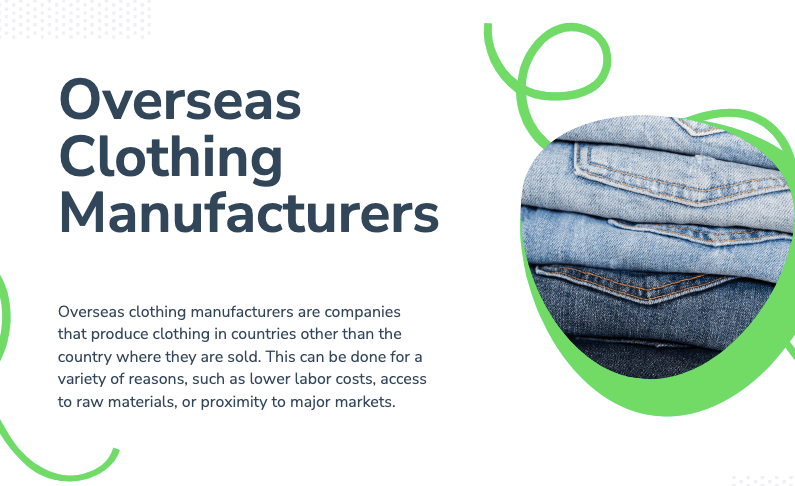Choosing between a domestic clothing manufacturers and an global overseas clothing manufacturer involves considering various factors. Here are 10 pros and cons for each option:
Domestic Clothing Manufacturer:
Pros:
- Faster Turnaround Times:
- Production timelines of home clothing manufacturing are often shorter due to proximity, enabling quicker response to market demands.
- Easier Communication:
- Communication barriers are minimized as you share a common language and are in the same or similar time zones.
- Better Quality Control:
- Closer proximity allows for easier oversight and control over the manufacturing process, ensuring higher quality standards.
- Support for Local Economy:
- Choosing a domestic manufacturer supports local businesses, contributing to the growth of the domestic economy.
- Ethical and Environmental Considerations:
- Reduced carbon footprint and adherence to local environmental and labor regulations may align with sustainable and ethical practices.
- Flexibility in Order Quantities:
- Domestic manufacturers may be more willing to accommodate smaller order quantities, supporting startups and small businesses.
- Intellectual Property Protection:
- Potentially stronger legal frameworks for protecting intellectual property rights in domestic markets.
- Easier Returns and Exchanges:
- Dealing with returns and exchanges is typically more straightforward due to shorter shipping distances if you choose local clothing manufacturers.
- Cultural Alignment:
- Shared cultural values may lead to a better understanding of design preferences and market trends.
- Responsive to Market Changes:
- Local clothing manufacturers ability to quickly adapt to changing market trends and consumer preferences.
Cons:
- Higher Production Costs:
- Labor and production costs may be higher compared to overseas manufacturers, potentially impacting the overall product cost.
- Limited Specialized Skills:
- Limited availability of specialized skills or technologies for specific types of production.
- Limited Capacity:
- Domestic manufacturers may have limited production capacity compared to larger overseas facilities.
- Higher Overhead Costs:
- Operating costs for facilities, utilities, and labor may be higher, contributing to increased product costs.
- Limited Material Sourcing:
- Limited access to certain raw materials, which may need to be imported, adding to costs and potential delays.
International Overseas Clothing Manufacturer:
Pros:
- Lower Production Costs:
- Overseas manufacturers often offer lower labor and production costs, contributing to overall cost savings.
- Access to Specialized Skills:
- Global clothing manufacturers usually have access to a broader range of specialized skills and technologies for various types of production.
- Higher Production Capacity:
- Offshore clothing factory usually has a larger facilities, which can handle higher production volumes, suitable for scaling up operations.
- Diverse Material Sourcing:
- Access to a wide range of raw materials, potentially leading to more diverse product offerings.
- Economies of Scale:
- Cost advantages due to economies of scale, especially for larger production runs.
- Potential for Innovation:
- Exposure to different manufacturing practices and innovation in production methods.
- 24/7 Production Capability:
- Time zone differences allow for continuous production and progress updates.
- Tax Incentives:
- Some countries offer tax incentives or subsidies for manufacturing businesses.
- Regulatory Flexibility:
- Potentially less stringent regulatory environments in certain regions.
- Global Market Access:
- Ability to tap into international markets and diverse consumer bases.

Cons:
- Longer Lead Times:
- Shipping times and customs procedures can result in longer lead times, impacting time-to-market.
- Communication Challenges:
- Language barriers and time zone differences may complicate communication and coordination.
- Quality Control Challenges:
- Ensuring consistent quality may be challenging due to physical distance and cultural differences.
- Intellectual Property Risks:
- Potential concerns regarding intellectual property protection in some overseas markets.
- Minimum Order Requirements:
- Overseas manufacturers may have higher minimum order requirements, challenging for small businesses.
- Hidden Costs:
- Unforeseen costs such as customs duties, taxes, and shipping fees can add up.
- Dependency on Global Supply Chain:
- Vulnerability to disruptions in the global supply chain, such as geopolitical events or natural disasters.
- Cultural and Trend Alignment:
- Understanding local market trends and cultural preferences may be challenging.
- Ethical and Environmental Concerns:
- Compliance with ethical and environmental standards may vary, requiring thorough vetting.
- Risks of Counterfeiting:
- Increased risk of counterfeiting and unauthorized reproduction of designs.
The choice between a domestic and global offshore clothing factory manufacturer depends on various factors, including production scale, budget constraints, product complexity, and the target market. Careful consideration of these pros and cons of home clothing manufacturing factories will help in making an informed decision.




